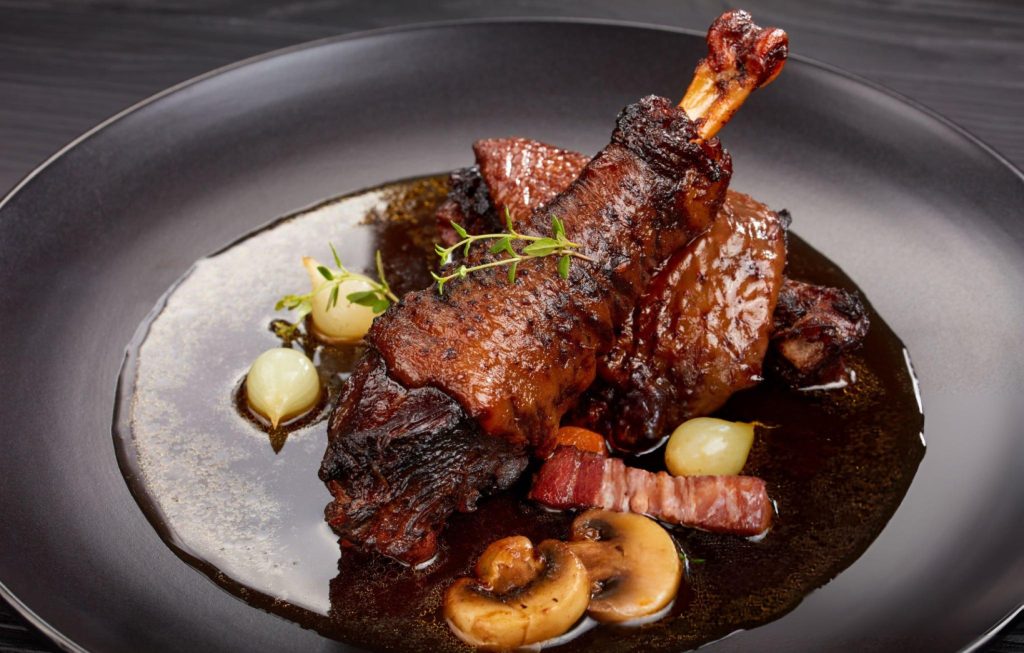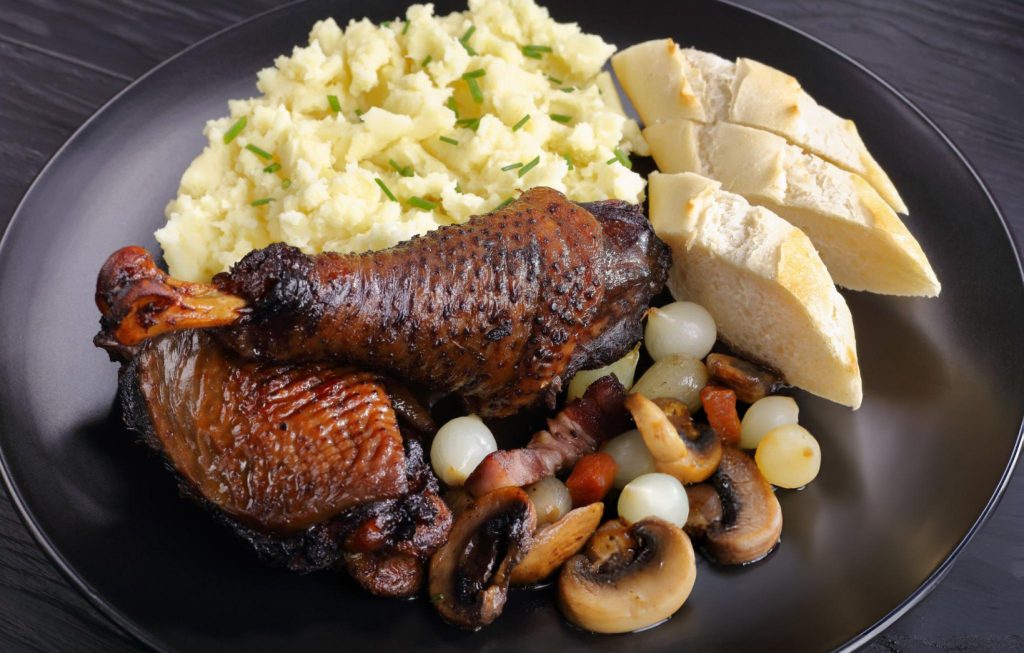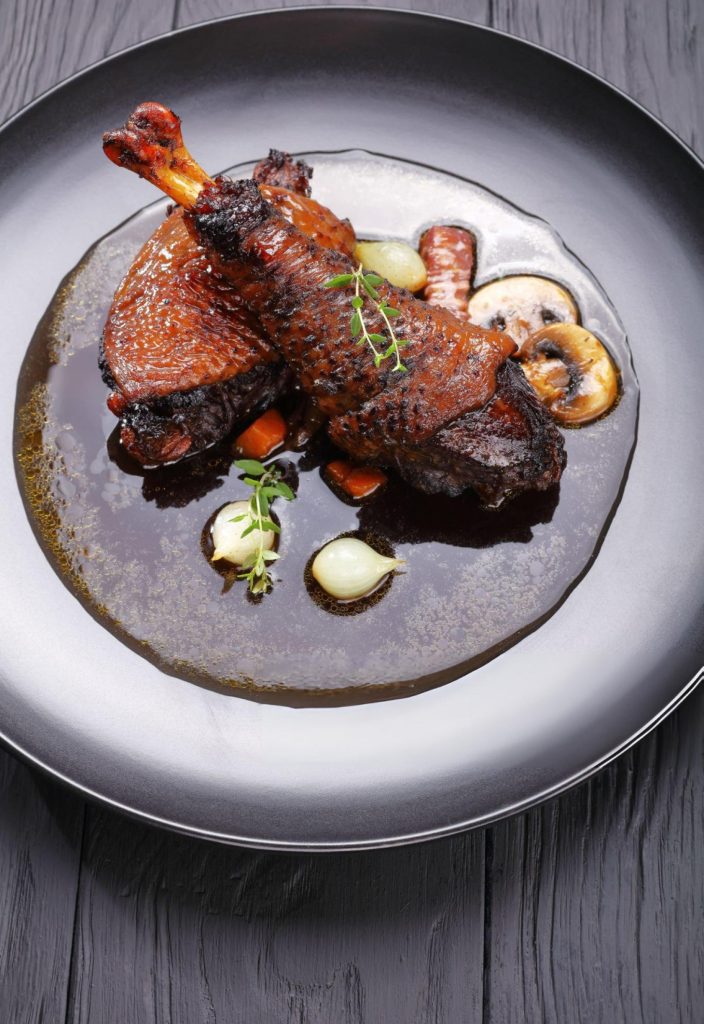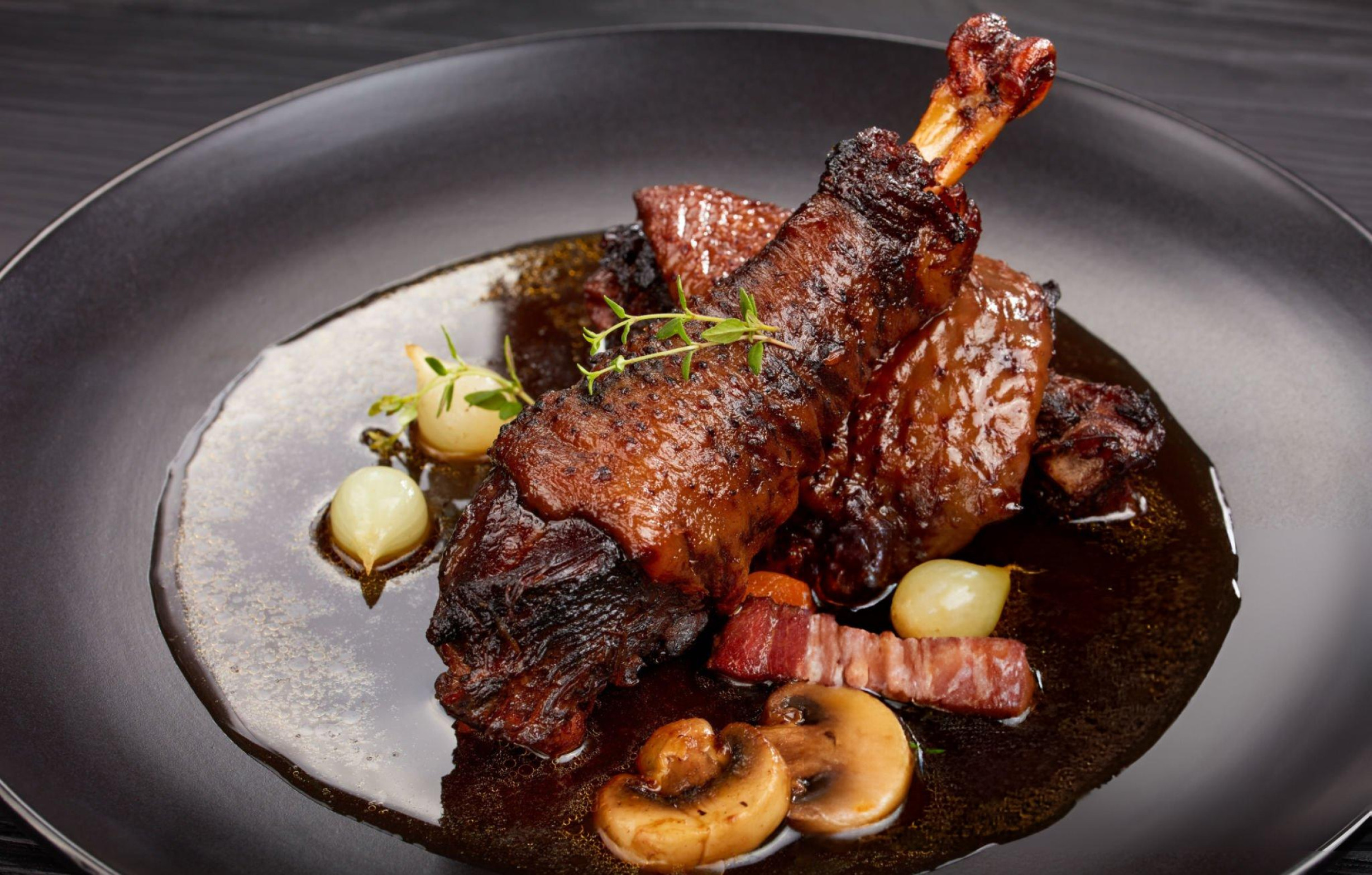Coq au Vin Recipe
Coq au Vin is a quintessential French dish that embodies the elegance and richness of traditional French cuisine. This mouthwatering recipe, steeped in history, brings together tender chicken, aromatic herbs, and the robust flavor of red wine, creating a stew that is perfect for special occasions or a comforting family meal. The combination of slow-cooked chicken infused with the deep flavors of wine and bacon results in a dish that is both hearty and sophisticated, offering a taste experience that transports you straight to the heart of France.

What sets this recipe apart is the careful selection of ingredients and the meticulous slow-cooking technique that ensures each element melds perfectly with the others. The rich sauce, made from a reduction of red wine and beef stock, envelops the chicken in a velvety embrace, while the addition of mushrooms and bacon adds layers of earthy, smoky flavors. The final touch of fresh parsley provides a vibrant contrast, making this dish as visually appealing as it is delicious.
Ingredients Breakdown
To create the perfect Coq au Vin, it’s essential to start with high-quality ingredients. The choice of wine is paramount; a good Pinot Noir or any dry red wine with a full body will impart the depth of flavor that characterizes this dish. Fresh thyme and bay leaf add aromatic notes that elevate the stew, while the use of bone-in, skin-on chicken ensures the meat remains juicy and flavorful throughout the cooking process.
The selection of mushrooms plays a crucial role as well. White mushrooms are a classic choice, providing a mild yet earthy flavor that complements the richness of the sauce. The inclusion of bacon, or speck, introduces a smoky element that balances the sweetness of the caramelized onions and the acidity of the wine. For those looking to experiment, consider substituting the mushrooms with wild varieties for a more intense flavor, or use boneless chicken thighs for a quicker cooking time.
For those who prefer a variation, this recipe can easily be adapted. Try using a different type of mushroom, such as cremini or shiitake, to bring a different texture and taste to the dish. You could also experiment with other cuts of meat; beef or lamb would work well, offering a heartier alternative to chicken. For a vegetarian version, substitute the chicken with hearty vegetables like eggplant or portobello mushrooms, and replace the beef stock with a rich vegetable broth.
Step-by-Step Cooking Instructions
The first step in making Coq au Vin is marinating the chicken. This crucial process allows the flavors of the wine, thyme, and bay leaf to deeply penetrate the meat, ensuring that each bite is infused with the essence of the marinade. Allow the chicken to marinate for at least 12 hours, and up to 24 hours, to achieve the best results. The longer the marination, the more intense the flavors will be.
Once the chicken is marinated, the next step is browning the chicken and vegetables. This step is essential as it develops a deep, caramelized crust on the chicken, which adds complexity to the final dish. The bacon is rendered until golden, releasing its fat, which is then used to sauté the mushrooms and onions. This layering of flavors is what gives Coq au Vin its signature taste.
The final cooking process involves simmering the chicken in the reduced wine and beef stock. Slow-cooking allows the flavors to meld together, creating a rich and luxurious sauce. The key is to maintain a gentle simmer, ensuring that the chicken becomes tender without falling apart. This method not only enhances the flavor but also results in a dish that is as pleasing to the palate as it is to the eye.

Recipe Tips & Frequently Asked Questions
- Choosing the Right Wine: Opt for a full-bodied, dry red wine such as Pinot Noir. The quality of the wine will directly impact the depth of flavor in the final dish.
- Preparing Ahead: Coq au Vin is a perfect make-ahead dish. Prepare it a day in advance to allow the flavors to develop fully. When reheating, add a splash of water to loosen the sauce if necessary.
- Adjusting the Seasoning: Taste the sauce before serving and adjust the seasoning. The saltiness can vary depending on the bacon used, so it’s important to taste and adjust as needed.
- Perfect Side Dishes: Pair Coq au Vin with creamy mashed potatoes or buttery tagliatelle. The richness of the sauce complements the smoothness of these sides perfectly.
- Bread Pairings: Serve with homemade brioche or a crusty French baguette to mop up the delicious sauce.
- Wine Pairings: Pair this dish with the same wine used in the cooking process. A full-bodied red will enhance the flavors of the stew.
- Can I Use a Different Type of Meat? Yes, beef or lamb can be used as a substitute for chicken. Adjust the cooking time accordingly.
- How Do I Store Leftovers? Store the leftovers in an airtight container in the fridge for up to three days. Reheat gently on the stove, adding a bit of water if the sauce has thickened.
- Is It Possible to Make This Dish Without Wine? For a non-alcoholic version, replace the wine with a combination of beef stock and grape juice. The flavor will differ slightly, but it will still be delicious.
Recipe Tips for Success
Avoiding common mistakes can make or break your Coq au Vin experience. Ensure the wine is properly reduced to concentrate its flavors, and be cautious not to overcook the chicken, as it should be tender but not falling apart. Achieving the perfect sauce consistency requires patience; slowly adding the stock while stirring continuously will help prevent lumps. Making the recipe your own is part of the fun—experiment with different herbs, spices, and sides to find your perfect version of this classic dish.
Coq au Vin is more than just a meal; it’s an experience. The deep, rich flavors and the comforting aroma that fills your kitchen as it simmers on the stove make it a dish worth savoring. Whether you’re serving it for a special occasion or simply enjoying it as a hearty family meal, this recipe is sure to impress. Take the time to prepare it with care, and you’ll be rewarded with a dish that is as delightful to eat as it is to make.
As you embark on your Coq au Vin journey, don’t hesitate to share your results and any creative twists you’ve added. Cooking is an art, and every version of this classic recipe tells a unique story.

Ingredients
Browning Chicken:
- 3-4 tbsp vegetable oil (or canola oil)
- 3/4 tsp kosher salt (or 1/2 tsp table salt)
- 1/2 tsp freshly ground black pepper
- 4 chicken drumsticks (Note 1)
- 4 chicken thighs, bone-in, skin-on (~220g / 7 oz each) (Note 1)
Coq au Vin Stew:
- 60g / 4 tbsp unsalted butter
- 3 garlic cloves, finely minced
- 2 tbsp tomato paste
- 7 tbsp all-purpose flour
- 750 ml / 3 cups low-sodium beef stock, ideally homemade (Note 6)
- 400g / 14oz white mushrooms, halved or quartered if large (Note 4)
- 150g / 5oz bacon (speck), sliced into 1 x 2.5cm / 0.4 x 1″ batons (Note 5)
- 1/4 tsp kosher salt (or 1/8 tsp table salt) (Note 7)
- 1/4 tsp freshly ground black pepper
Red Wine Chicken Marinade:
- 750 ml / 3 cups Pinot Noir or another dry red wine (Note 3)
- 16 pearl onions or pickling onions (Note 2)
- 3 sprigs of thyme (substitute with 1 tsp dried thyme)
- 1 bay leaf, fresh or dry
- Chicken (as mentioned above)
Garnish and Serving:
- 2 tbsp fresh parsley, chopped
- Mashed potatoes or tagliatelle for serving
Instructions
Marinate Chicken:
- In a large glass or ceramic dish, combine all the ingredients for the Chicken Marinade. Submerge the chicken and onions, then refrigerate for at least 12 hours, or up to 24 hours for maximum flavor infusion.
- After marinating, strain the wine into a bowl, reserving both the wine and the herbs. Separate the chicken and onions from the marinade.
- Pat the chicken dry with paper towels after spreading it out on a tray lined with paper towels.
- In a saucepan, bring the reserved red wine to a boil over medium-high heat. Simmer vigorously, skimming off any impurities from the surface, until the wine reduces by half. Set aside.
Brown Chicken and Vegetables:
- Preheat your oven to 180°C / 350°F (160°C fan).
- Season the chicken with 3/4 tsp of kosher salt and 1/2 tsp of black pepper.
- Heat 3 tbsp of oil in a large, heavy, oven-proof pot over medium-high heat. Brown the chicken thighs, skin side down, for 2-3 minutes until deeply colored, then flip and cook for another minute. Transfer to a tray. Pull the skin over the drumsticks to cover the flesh as much as possible, then brown them on 3-4 sides, about 5 minutes in total. Set aside.
- Remove any loose burnt bits from the pot, and add a bit more oil if needed. Cook the bacon for about 3 minutes until golden, then transfer to the tray with the chicken.
- In the same pot, sauté the mushrooms for about 5 minutes until they turn golden. Remove and set aside in a separate bowl.
- Sauté the onions in the pot for about 5 minutes until they develop nice golden patches.
- Melt the butter in the pot. Once melted, add the minced garlic and cook for about 1 minute. Stir in the tomato paste and cook for 2 minutes. Sprinkle the flour over the mixture and cook for another 2 minutes.
- Gradually stir in the beef stock while stirring continuously to help the flour dissolve smoothly. Add the reduced wine and mix until the flour mixture is fully incorporated and mostly lump-free (Note 8).
- Return the chicken, bacon, mushrooms, thyme, bay leaf, salt, and pepper to the pot. Stir everything together.

Coq au Vin Recipe
Ingredients
Browning Chicken:
- 3-4 tbsp vegetable oil or canola oil
- 3/4 tsp kosher salt or 1/2 tsp table salt
- 1/2 tsp freshly ground black pepper
- 4 chicken drumsticks Note 1
- 4 chicken thighs bone-in, skin-on (~220g / 7 oz each) (Note 1)
Coq au Vin Stew:
- 60 g / 4 tbsp unsalted butter
- 3 garlic cloves finely minced
- 2 tbsp tomato paste
- 7 tbsp all-purpose flour
- 750 ml / 3 cups low-sodium beef stock ideally homemade (Note 6)
- 400 g / 14oz white mushrooms halved or quartered if large (Note 4)
- 150 g / 5oz bacon speck, sliced into 1 x 2.5cm / 0.4 x 1″ batons (Note 5)
- 1/4 tsp kosher salt or 1/8 tsp table salt (Note 7)
- 1/4 tsp freshly ground black pepper
Red Wine Chicken Marinade:
- 750 ml / 3 cups Pinot Noir or another dry red wine Note 3
- 16 pearl onions or pickling onions Note 2
- 3 sprigs of thyme substitute with 1 tsp dried thyme
- 1 bay leaf fresh or dry
- Chicken as mentioned above
- Garnish and Serving:
- 2 tbsp fresh parsley chopped
- Mashed potatoes or tagliatelle for serving
Instructions
Marinate Chicken:
- In a large glass or ceramic dish, combine all the ingredients for the Chicken Marinade. Submerge the chicken and onions, then refrigerate for at least 12 hours, or up to 24 hours for maximum flavor infusion.
- After marinating, strain the wine into a bowl, reserving both the wine and the herbs. Separate the chicken and onions from the marinade.
- Pat the chicken dry with paper towels after spreading it out on a tray lined with paper towels.
- In a saucepan, bring the reserved red wine to a boil over medium-high heat. Simmer vigorously, skimming off any impurities from the surface, until the wine reduces by half. Set aside.
Brown Chicken and Vegetables:
- Preheat your oven to 180°C / 350°F (160°C fan).
- Season the chicken with 3/4 tsp of kosher salt and 1/2 tsp of black pepper.
- Heat 3 tbsp of oil in a large, heavy, oven-proof pot over medium-high heat. Brown the chicken thighs, skin side down, for 2-3 minutes until deeply colored, then flip and cook for another minute. Transfer to a tray. Pull the skin over the drumsticks to cover the flesh as much as possible, then brown them on 3-4 sides, about 5 minutes in total. Set aside.
- Remove any loose burnt bits from the pot, and add a bit more oil if needed. Cook the bacon for about 3 minutes until golden, then transfer to the tray with the chicken.
- In the same pot, sauté the mushrooms for about 5 minutes until they turn golden. Remove and set aside in a separate bowl.
- Sauté the onions in the pot for about 5 minutes until they develop nice golden patches.
- Melt the butter in the pot. Once melted, add the minced garlic and cook for about 1 minute. Stir in the tomato paste and cook for 2 minutes. Sprinkle the flour over the mixture and cook for another 2 minutes.
- Gradually stir in the beef stock while stirring continuously to help the flour dissolve smoothly. Add the reduced wine and mix until the flour mixture is fully incorporated and mostly lump-free (Note 8).
- Return the chicken, bacon, mushrooms, thyme, bay leaf, salt, and pepper to the pot. Stir everything together.
Slow-Cook:
- Bring the mixture to a simmer, cover the pot, and transfer it to the preheated oven. Allow it to cook for 45 minutes until the chicken is tender but not falling apart (Note 9).
- After cooking, taste the sauce and adjust the salt if necessary.
- If time allows, refrigerate the stew overnight (recommended, Note 11). Like most stews, the flavor deepens and improves with time. Reheat gently over low heat on the stove, ensuring the chicken is thoroughly warmed. Add a splash of water if the sauce needs loosening.
- Serve the Coq au Vin over mashed potatoes or tagliatelle, garnished with chopped parsley. For the ultimate dining experience, mop up any remaining sauce with homemade brioche. See the main recipe post for side salad and dessert pairing options.
Notes
- Chicken Pieces: Opt for bone-in, skin-on chicken pieces for the juiciest and most tender results. If possible, cut up a whole chicken yourself. For chicken breasts, keep them whole with the skin on and bone in. Marinate and sear as directed, but only add them to the pot for the last 20 minutes in the oven to prevent overcooking and drying out.
- Pearl Onions: These small onions can be tricky to find, especially in Australia. Pickling onions are a suitable alternative; they are slightly larger, so peel off an extra layer or two to achieve the desired size of about 2.5 cm (1 inch) in diameter. Soaking them in cold water for 10-15 minutes will soften the skins, making them easier to peel—use a small knife to assist. If pearl onions are unavailable, you can substitute with two brown or yellow onions, halved and cut into 1 cm (2/5 inch) wedges.
- Wine Selection: Pinot Noir is the traditional choice for Coq au Vin, though various wine regions may showcase their local wines in this dish, with some even using champagne. While wine is the primary flavoring, there’s no need to splurge on an expensive bottle. Contrary to popular belief, even budget wines can produce excellent results, especially after being cooked for an extended period. The braising process, combined with the other ingredients, transforms the wine into a rich, flavorful sauce. For example, a $15 bottle reduced to $6 can work wonders. While the alcohol mostly cooks off during the lengthy cooking process, consider whether any residual alcohol in the chicken might be a concern, especially when serving children.
- Mushrooms: Swiss brown or cremini mushrooms are a fine substitute for the traditional white mushrooms, though white mushrooms offer a more striking visual contrast against the dark brown sauce.
- Bacon: Using a block of bacon allows you to cut it into thick batons, which gives a more appealing look in the finished dish. While sliced bacon can be used as a substitute without compromising flavor, it results in smaller pieces, making the sauce appear chunkier. Bacon is crucial for seasoning the sauce, so don’t skip it!
- Beef Stock: The use of beef stock contributes to the rich, dark brown color and adds depth to the flavor without overpowering the dish with a beefy taste, as the chicken juices dominate. While chicken stock can be used as a substitute, the sauce will be lighter in color and flavor. The quality of the beef stock is what distinguishes a good homemade Coq au Vin from an exceptional one. Homemade beef stock is ideal, but if using store-bought, opt for high-quality options from butchers or specialty shops over mass-produced brands. Avoid powdered beef stock, as it lacks the depth and quality needed for this dish.
- Salt: The dish receives plenty of salt from the bacon, so minimal additional salt is required.
- Flour Lumps: Don’t worry if you notice a few lumps of flour—they will dissolve during the slow cooking process.
- Slow Cooking Method: The oven method is preferred as it’s hands-off, with no need to stir to prevent the base from catching (which can be challenging with large chicken pieces). However, it can also be done on a low stove with the lid on, stirring occasionally. If using a slow cooker, you’ll need to reduce the sauce on the stove afterward to thicken it—slow cook on low for 6 hours, then transfer to a pot and simmer uncovered for 15-20 minutes until the sauce reduces. The oven method is generally easier.
- Chicken Tenderness: The chicken should cook through and become tender in about 45 minutes, though it should not be “falling off the bone,” which is different from other slow-cooked meats like beef chuck, lamb shanks, or beef ribs. Chicken naturally requires less time to become tender.
- Leaving Stew Overnight: Like many stews, Coq au Vin benefits from being left overnight, particularly when made with wine-based sauces like this one or Beef Bourguignon. The flavors deepen, and any residual wine flavor mellows out over time. However, it’s equally delicious when served fresh.

